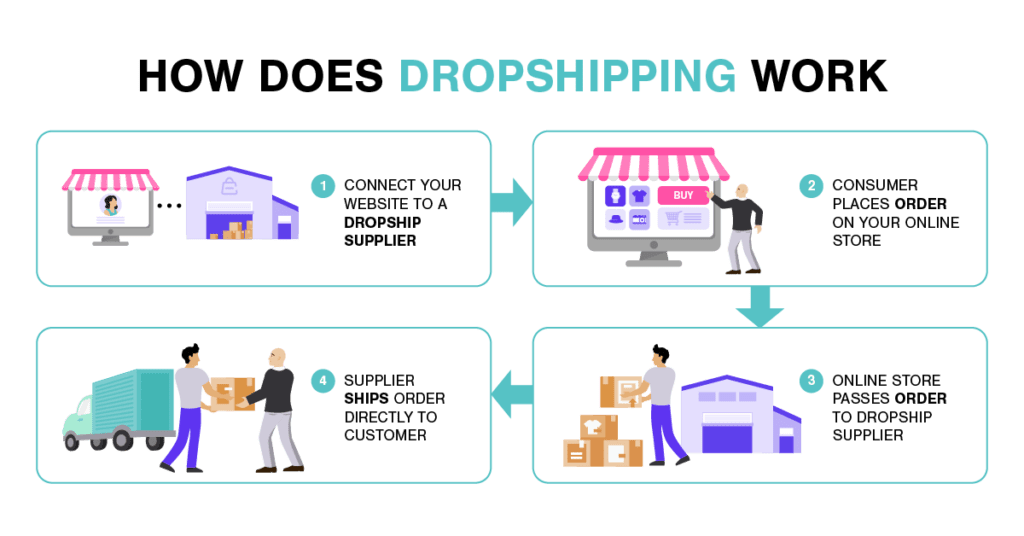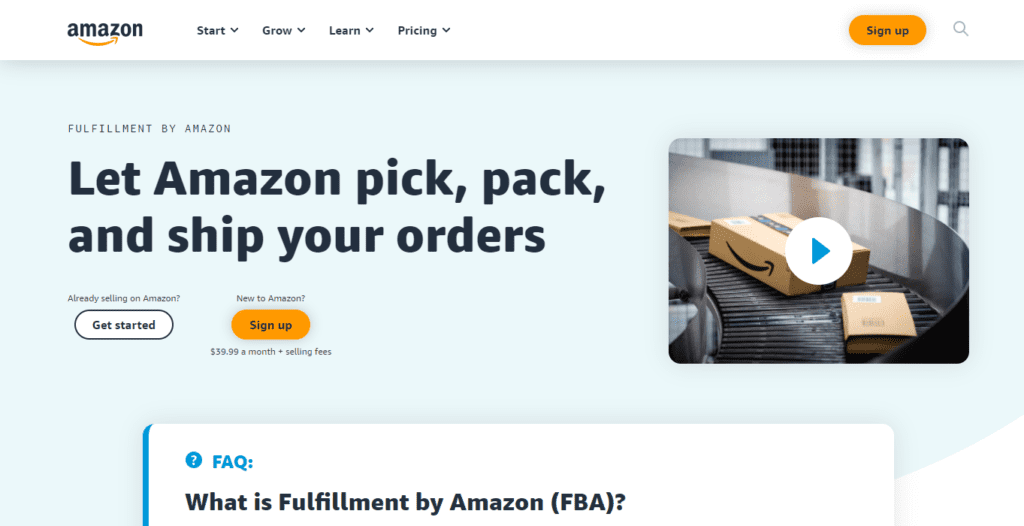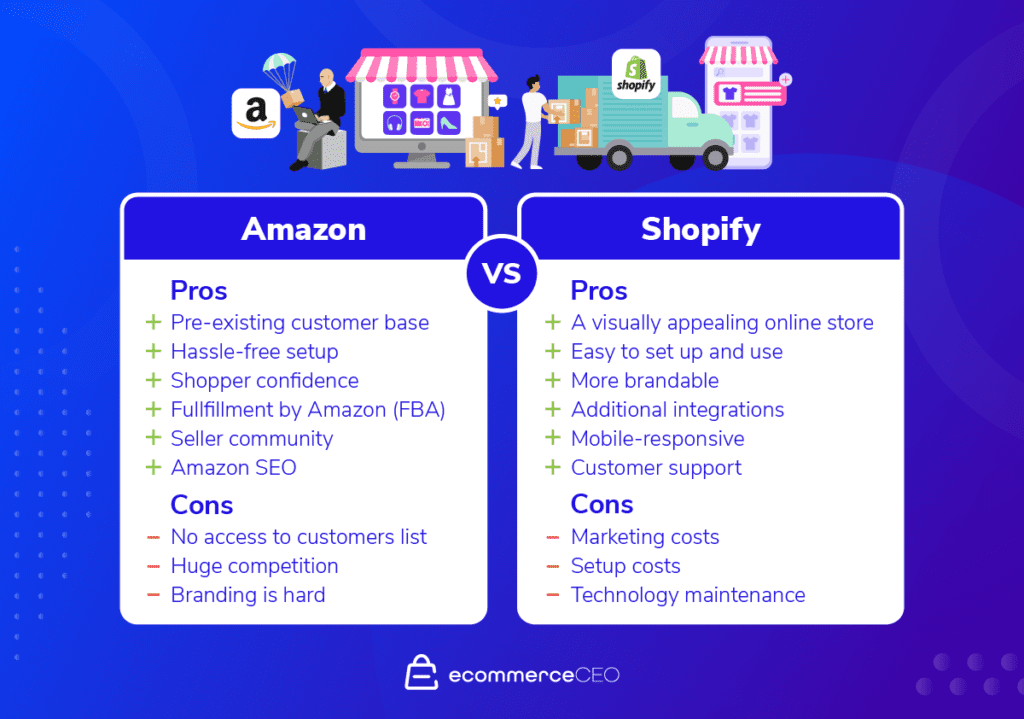Shopify and Amazon are two of the world’s most popular options when it comes to selling products online.
In fact, there are currently as many as 5 million sellers across all Amazon marketplaces and 600,000 on Shopify. But despite both platforms’ ever-growing popularity in a similar market sector, they actually take very different approaches when it comes to being a vessel for online sales.
So how it is that Shopify and Amazon differ? And which of the two would be better for your business?
Shopify 101
Shopify is an eCommerce software that allows you to build your own online store and customize it with a wide array of features. The cloud-based platform operates on a subscription-based model, giving you access to everything you pay for within that subscription.
Through Shopify, you can manage all the necessary eCommerce functionalities, such as product listings, store design, secure payments, and shipping for your online stores.
The benefits of using Shopify
Shopify is one of the best ways to sell your products online, especially if you’re dropshipping. Selling with Shopify has a number of significant advantages, including:
Ease of use
Despite needing to set up a shop yourself, Shopify is remarkably easy to use, especially once you’re past that initial setup. The simple and clear interface, along with professional themes and templates ensures that both you and your customers can find your way around the store quickly and without hassle. All Shopify plans also come with an SSL certificate included, meaning you can sell securely from the get-go.

Flexibility
Flexibility is one of the strong points of Shopify. That is because you can personalize large elements of your store, allowing you to get them just right for your customers. The platform allows you to offer customers a choice of a huge number of payment gateways, currencies, and even delivery options. All of which makes it ideal to construct a store that is perfect for your buyers.
Language availability
With Shopify, you can create a storefront in any language of your choice. You can even set several languages if you aim to sell globally. By including multiple language options on a single store, you increase the chances of sales as users can browse in their preferred language.
Customization
Customization is arguably the main selling point of Shopify. Shopify allows you to choose from a wide range of themes and templates. Within those templates, you can even make your own changes. This means that you can create a truly unique store in every sense of the word.
In addition to themes and templates, you can also personalize how your payment options, how you ship your products, the language of your store, the depth of your store’s features, and much more.
Learning growth
Shopify isn’t just a great platform to sell on, but a great platform to learn how to improve your selling skills. The software brand provides a wide range of learning tools and materials to its customers, so you can learn how to improve your store and its effectiveness. These resources come in the form of articles, how-to guides, and online courses.
Business growth
As Shopify allows an extensive level of customization with stores and offers a range of pricing plans, you can ensure you always have the necessary features to sell economically. Should your business grow, you can purchase a more extensive plan at any time, and have access to even more features.
Customer service
When you sign up for any of Shopify’s payment plans, the platform also gives you access to its 24/7 customer service. So should you or your customers experience any issues, they can be resolved quickly and efficiently.
In addition to that, you will also receive tools to reduce the need for customer support. These include the ability to show other customers reviews and an image zoom feature.
Fulfillment options
On Shopify, order fulfillment is completely up to you. If you want total control of your order fulfillment then you can have that. Alternatively, if you are low on time you can use a third-party service for your inventory management and logistics. Third-parties will charge you a small fulfillment fee for their work, but ensure you can focus your efforts on other aspects of your business.
The downsides to using Shopify
Whilst Shopify may be a very effective platform to sell on, there are a couple of drawbacks. Such as:
The build-up of additional costs
Whilst the initial pricing plans on Shopify have a reasonable cost for what they offer, the add ons on the platform can quickly tot up. Add-on apps can also make pricing quite challenging to judge, especially when you also consider transactional costs too. However, many of these apps are necessary if you have to keep improving your store.
Lack of pre-existing reputation
When you use Shopify to create your store, you essentially create a brand new store from scratch. This means you do not have the initial pre-existing reputation to give you a head start. Instead, you have to build up that reputation yourself, which takes time. This can make initial sales challenging and require a lot of work.
Limitations on video content
Unlike many marketplaces, Shopify does not currently allow video content to be added to your listings. Similarly, it also doesn’t allow gifs or related media forms either. The lack of this capability can be detrimental in some regards, as many customers like to see a product in action before buying.
More challenging initial set up
Despite the pre-made templates and themes on Shopify, familiarizing yourself with the platform and all its jargon can be a challenge, to begin with. The process can be time-consuming, and take a good degree of effort until you get used to it if you are a first-time user. And even if you have made a Shopify store before, building a store from scratch takes time.
More marketing required
As your shop will have no existing reputation when you create it, you will need to build your brand awareness and market your products. It can take time, effort, and money to make potential customers aware of your store. The process can be a difficult one, and there is no recipe for instant success.
You will also need to conduct your own research and work out where your target audience will be likely to see your ads. Once you’ve managed that and run a few successful advertising campaigns, customers should start to slowly filter in.
Limitations on the basic plan
Not all of Shopify’s features are available on every pricing plan. Therefore, if you want access to everything you will need to pay more for the pricier plans. This lack of access to all the platform materials can be challenging for smaller business owners with lesser budgets.
Why Sell on Amazon
Amazon is the world’s largest and most popular marketplace. It is the main online marketplace in multiple countries across the globe, including the United States, United Kingdom, Spain, Germany, and many others.
As a marketplace, Amazon allows retailer to list their products online, through their platform which has a pre-established reputation. You can sell on Amazon using either an individual account or a professional seller account.
Marketplaces like Amazon allow customers to search for a wide variety of products in one place. Because of Amazon’s reputation, it is already a go-to for many consumers. This means you can immediately tap into a substantial customer base.
The benefits of using Amazon
As the world’s largest online marketplace, there are undoubtedly plenty of benefits to selling on Amazon. Here are just a few of the main ones:
The platforms established reputation
Amazon is a well-known brand, which is highly beneficial for eCommerce sellers on the platform. This is because Amazon has already established trust with customers, and even has regular buyers. Therefore, you can tap into a pre-established market when selling on the platform.
The platforms extensive traffic
Because Amazon is the world’s most popular marketplace, you have a massive amount of traffic to sell your products to. This is a great opportunity for any business, especially if you want to test the water for new product releases or test your business model.
Fulfillment by Amazon
Like Shopify, Amazon also allows you to take care of your own fulfillment if you so choose. However, if you’d prefer to save time and effort, you can use fulfillment by Amazon (FBA). FBA allows you to focus on other areas of your business, while Amazon takes care of fulfillment for you, at a small cost.
FBA ensures that your items delivered quickly and efficiently, whilst also dealing with storage for you. This process, known as dropshipping cuts out the middleman, with products going straight from the Amazon warehouse to the customer.

In most dropshipping scenario’s, the store’s only requirement is to pass on the order, and in this case it is automatically received by Amazon anyway. This allows deliveries to reach the customer at a faster rate, with Amazon receiving a part of the profit for their service. This helps businesses get better reviews, as well as allowing them to sell through Amazon Prime delivery.

Another useful element of using FBA is the contribution it makes towards winning the all-important Buy Box. An increased chance at the Buy Box means your product has a higher chance of being one of the more visible. This leads to more sales on the platform.
Easy setup
Setting up and selling on Amazon is incredibly simple, as most things are already done for you. All you need to do is create an individual account, or a professional account and then begin to list all your products according to Amazon’s regulations.
It is possible to add additional features, such as branding to your page. If you want to add elements like this, then it will take a little more time. However, the essential setup is quick and easy.
Built-in reporting tools
Amazon has various built-in reporting tools to help guide you when selling on the platform. These reports can show you how much you sold, when you sold it, the amount of traffic on each product page, and much more. When gathered over longer periods of time, this data can assist you in improving your product listings in the future.

Simple refunds and returns
Amazon has high standards for refunds and returns if a customer is not satisfied with what they receive. But despite these standards being high, they are also fair on merchants. Amazon makes refunds and returns clear and easy for both customers and sellers. It also acts as a middleman between the two, ensuring that both sides receive fair treatment in disputes.
Round the clock customer support
If you are having any issues whilst selling on Amazon, the platform has constant support ready to assist you. In addition, if you use Amazon FBA, the platform will also assist you with customer service for your buyers when they have issues if you so choose.
Access to Amazon Seller Central
Although Amazon doesn’t offer courses like Shopify, it does give you access to Seller Central if you have a professional account. Seller Central is essentially a forum for the platform’s professional sellers with plenty of information on how to effectively sell on the platform. You can view the latest Amazon updates, ask questions to the community, or find guides on how to do certain things all within a few clicks.
The downsides to using Amazon
Whilst there are plenty of positives to selling on Amazon, the site still has a few drawbacks. Here are the main ones:
A lot of competition
Due to its popularity with customers, merchants also congregate on Amazon. This creates extensive competition. And as there are few branding opportunities on the website, it is difficult to stand out from the crowd. In addition, many customers only look at the brand holding the Buy Box for a product, so if you fail to attain the Buy Box, you will perform noticeably worse. And with all the competition, the Buy Box is not something that is easy to attain.
Tight and strict regulations that must be adhered to
Amazon has very strict rules and regulations about how you can post listings. Images have certain parameters, titles have character limits, and branding also has limitations. Not following these requirements would lead to your products being removed and you losing out on vital sales, so all listings should be examined before you post them. This can not only be time-consuming but also tedious and challenging in terms of making your items stand out.
Limited customization and branding
With the exception of a small amount of leeway allowed on your brand page, Amazon allows almost no branding on its site. This makes it hard to stand out from your competitors and also limits your customization options.
Templates used for listings are not customizable in any way, so all listings follow the same structure. This causes them to all look identical to customers and makes companies almost unrecognizable and forgettable.
Certain items can have very high selling fees
Amazon’s selling fees depend on the product you are selling, and the category that product falls into. Sales fees start at around 15%, which is very reasonable. However, in some product categories, it can rise as high as a staggering 40%, which can deal a significant blow to any profits you intended to make from a sale.

The costs in a nutshell
Shopify
Shopify currently offers three different pricing plans depending on your needs. They are the basic Shopify plan, the Shopify plan, and the advanced Shopify plan. On Shopify, you will also pay fees for certain apps you use to enhance your store, and transactional fees (which are also based on the plan you select). Although the pricing plans give you a general idea of how much the platform will cost, you should also calculate any transaction fees, and consider which apps you will use beforehand. This will give you a better idea of the total costs for your business.
The details of the three Shopify pricing plans are as follows:
Basic Shopify plan
This plan costs a total of $39 a month, plus 2% transaction fees on all transactions not using Shopify payments. Basic Shopify offers Shopify’s base features, including unlimited product listings, support, manual order creation, and abandoned cart recovery.
Shopify plan
This plan costs $105 a month, plus 1% transaction fees on all transactions not using Shopify payments. The plan includes everything in Shopify’s basic plan, plus added features such as gift cards, professional reports, and up to 5 administrative accounts.
Advanced Shopify plan
This plan is the most expensive and comprehensive, coming in at a monthly fee of $399. There is also the cost of 5% transaction fees on all transactions not using Shopify payments. The Advanced Shopify plan includes all Shopify features available, including those in the cheaper plans.
Amazon
You can sell on Amazon as an individual seller or under a professional account. The costs of selling on the platform differ depending on which way you choose to sell, as well as where in the world you are selling. Here is a summary of the costs associated with both types of account in the United States:
Individual seller account
Individual sellers pay 99 cents per sale, plus referral fees (which are dependent on product category). You will also have to take into account your own delivery costs should you decide against FBA. If you choose to use FBA, you will pay a per-unit shipping fee on each order, as well as warehouse storage fees per cubic foot.
Professional account
Professional accounts on Amazon are charged $39.99 a month, plus referral fees (which again are dependent on product category). You will also either have to pay for your own delivery or for FBA. FBA costs are calculated in the same manner as an individual seller account.
By using a professional account, you get access to additional Amazon features, including:
- Reporting tools
- The ability to list products in bulk
- Eligibility for top product placement
- Eligibility to offer promotions
- Custom shipping rates
How is Shopify Different from Amazon
There are notable differences between selling on Amazon and Shopify. But which of those differences make the biggest impact when it comes to selling on the eCommerce platforms?
Payment benefits and limitations
Shopify excels in the area of payment. For starters, there are Shopify payments, which when used eliminates all transaction fees for merchants and customers alike. Then there is the other important factor, payment options. Shopify allows merchants to add pretty much whatever they want in terms of payment choices. This is ideal as customers can then choose their preferred method of payment and are more likely to complete their transactions.
Amazon on the other hand is highly limited when it comes to payment options, only offering a set few options. This can deter customers. It is also not possible to pay in installments on Amazon. Shopify stores can add this option if they so choose.
Set up
Set up on Shopify can be challenging, as you are building your own store from scratch. And even with ready-made themes and templates, certain changes will be required that take time and effort to adjust.
In contrast, Amazon only requires a simple sign-up before you can begin adding your listings. You can even use FBA to offset any storage and delivery work from the start, saving you more time and work.
Customization
The design of your Shopify store is very much in your control. You can choose your theme, edit it how you like it, add which apps you like, decide on the level of detail, and much more. Amazon does not afford you the same level of freedom. It offers little to no way to stand out from the competition and even has strict rulings on how you list your products.
Branding
On Amazon, branding is almost non-existent. Other than small changes to your store page, there is little you can really do to stand out from the competition. Contrastingly, Shopify allows you to choose from thousands of customizable templates and themes. This means you can create a unique store, that can make your brand memorable to customers.
Marketing
When you start selling on Amazon, you have a ready-made audience waiting for you. This means you have less of an obligation to market your business, as your customers are likely already using the trusted website.
On the other hand, Shopify stores are new entities. This means that you will be required to build up all your customer base yourself. This can be time-consuming and expensive. It also requires you to have some marketing and SEO knowledge.
Deciding on the platform to use for your business – Shopify or Amazon
Deciding between Shopify and Amazon is a tough prospect. Both platforms have a lot to offer. However, you have to consider what is right for your individual needs as a business. If you are just starting up, testing the waters, or still unsure if your products will really take off, it may be best to start on Amazon.
This is because Amazon is generally cheaper in the short term, and has a ready-made audience for your to reach.
On the other hand, if you have long terms goals for expanding your eCommerce business, Shopify may be ideal for you. Especially if you want your online business to be unique, and you’re willing to take the time to build up your customer base.
In the end, it comes down to what you are looking to gain from selling online, and the pros & cons of both platforms.
Consider using the platforms together
In some cases, it may even be best to use both Amazon and Shopify together. This could be in either a multi-channel or omnichannel strategy. By using both sales channels together, you have an increased chance of success, as more potential customers will be exposed to your brand.
Shopify has a ton of integrations, including Amazon.
Shopify Integrations and Plans
You may also be able to take advantage of Amazon’s substantial customer base and funnel Amazon customers into your Shopify store, turning more passive buyers into loyal customers. Whilst this approach using both platforms would cost you more, it may be the most fruitful option in the long run, if you have the budget to spare. Check out the Shopify App store for more extensions.
Final thoughts
There is no easy answer to whether Shopify or Amazon is better for your business. For some businesses Shopify will be the most suited, for others it will be Amazon. It could even be a combination of the two.
Both platforms have their pros and cons, so it is best to trial them against your goals and see what the outcome is before making a definitive decision.












